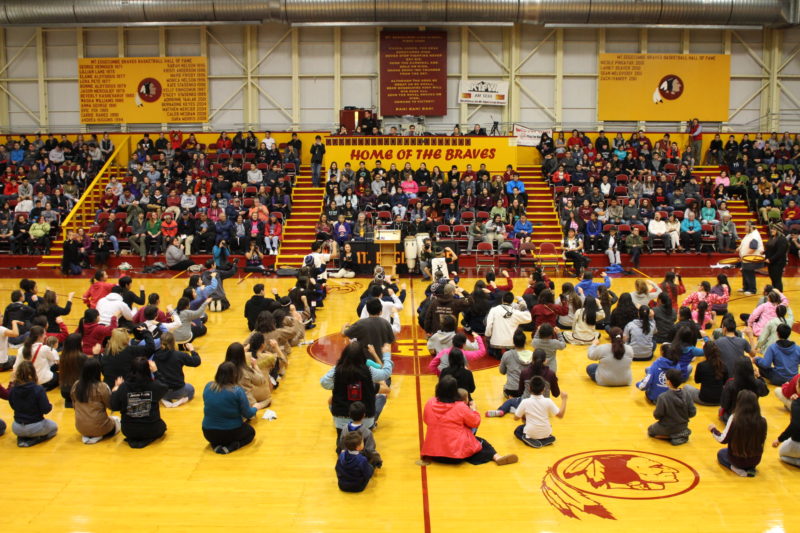
Students dance alongside Dancers by the Sea, a group from Port Lions, in celebration of Founders Week. (Emily Russell/KCAW)
Seventy years ago today, Feb. 22, 1947, the Bureau of Indian Affairs opened Mt. Edgecumbe High School in Sitka. BIA and other boarding institutions that operated in Alaska until the 1980s left some students traumatized, while others say it saved their lives.
Alumni from Mt Edgecumbe say their alma mater managed to avoid the darkest parts of that legacy. It reopened as a public boarding school in 1985 and a lot has changed over the decades.
Leann Frances mixes the last bag of berries into a massive stainless steel bowl.
It’s Sunday night at Mt. Edgecumbe and students line up for the sweet treat known as akutaq, or Eskimo ice cream. Frances explains.
“You mix the lard together until it gets fluffy and then you add in the sugar until it’s dissolved and then you add the berries.”
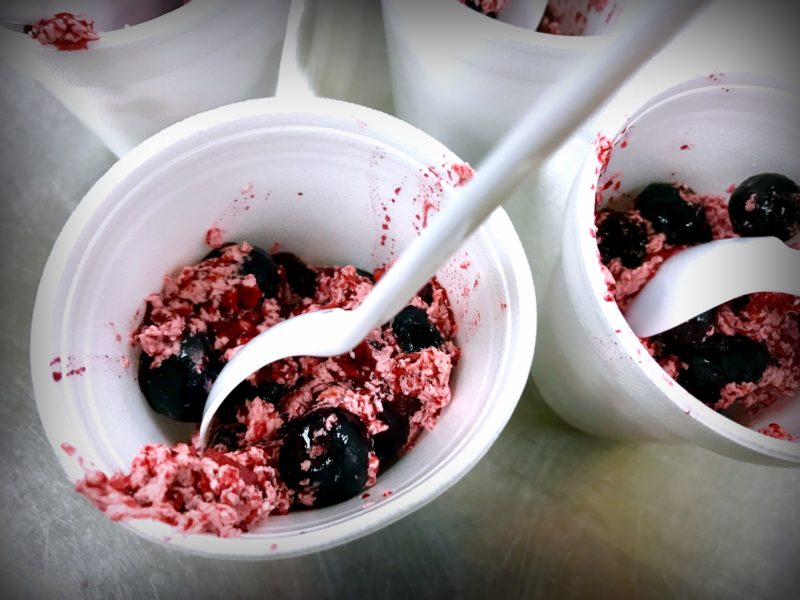
Akutaq, or Eskimo ice cream, is dished up every Sunday night in Mt. Edgecumbe’s Culture Room. (Emily Russell/KCAW)
Frances is a junior from Pilot Station, a Yup’ik village on the Yukon River. They eat akutaq there, but she said they add in some local flair.
“In Pilot Station we use whitefish. You just do the same things you just add in the fish,” Frances explains.
“There are a lot of Native cultures who do the same thing, who take dried meat, cooked meat, and add berries to it,” Rachel Moreno said.
Moreno is the cultural activities coordinator at Mt. Edgecumbe. “Some people put in a little bit of flaked halibut, some add caribou meat,” Moreno said.
The Edgecumbe version of akutaq is dished out every Sunday in the school’s Culture Room. It’s cluttered in here, but in a cozy way. There are glass jars full of beads and endless spools of thread scattered about.
Seventy years ago, though, there was no culture room. It barely even had classrooms.
“The classrooms– there were no chairs, no desks, no chalkboards, so we sat on the floor,” explained Gil Truitt.
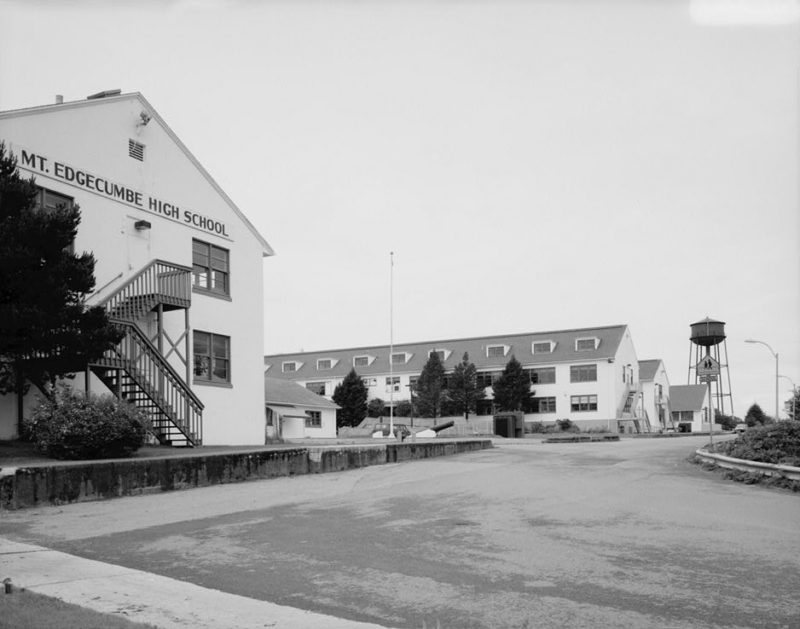
Mt. Edgecumbe High School opened in the Naval air station base used during WWII. (The Library of Congress)
Truitt was a student back in 1947. He moved from the Wrangell Institute, another BIA-run boarding school at the time. Wrangell was his first time away from home.
“To me that was really the beginning of my life, because I saw what a boarding school could be and what it could do,” Truitt said.
Truitt was orphaned at 14. He said the BIA saved him and his siblings and he says others share that sentiment– that boarding schools spared them from abuse or neglect at home.
But there’s another side to that story, the side that says the BIA punished kids for speaking their Native language, that kids were beaten and some even sexually abused.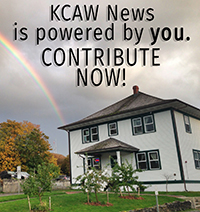
When asked about the history of abuse at BIA schools, Truitt defended both he attended.
“I know of no time at Edgecumbe or Wrangell where you were beaten for violating the rules,” Truitt said.
Jim LaBelle was sent to the Wrangell Institute when he just eight years old. “I saw lots of sexual violence, a lot of physical violence,” LaBelle said of his time at Wrangell.
Those were dark days, Labelle said. He went on to Mt. Edgecumbe in 1961.
When asked how the two schools compared, LaBelle said it was a stark difference.
“Oh my gosh, Labelle exclaimed, “it was kind of like turning on a light.”
Like Gil Truitt, Labelle looks back on his days at Edgecumbe with a real fondness. They both say it felt like family there.
A 2005 survey by UAA’s Institute for Social and Economic Research did report one allegation of sexual assault and three of sexual harassment at Mt. Edgecumbe, but neither Truitt nor LaBelle had memories of that.
LaBelle also doesn’t remember any students being punished at Edgecumbe for speaking their Native language like they were at Wrangell. It wasn’t exactly celebrated, though.
“There weren’t any instructions in our culture, in our language,” LaBelle explained. “It was all reading and writing and arithmetic.”
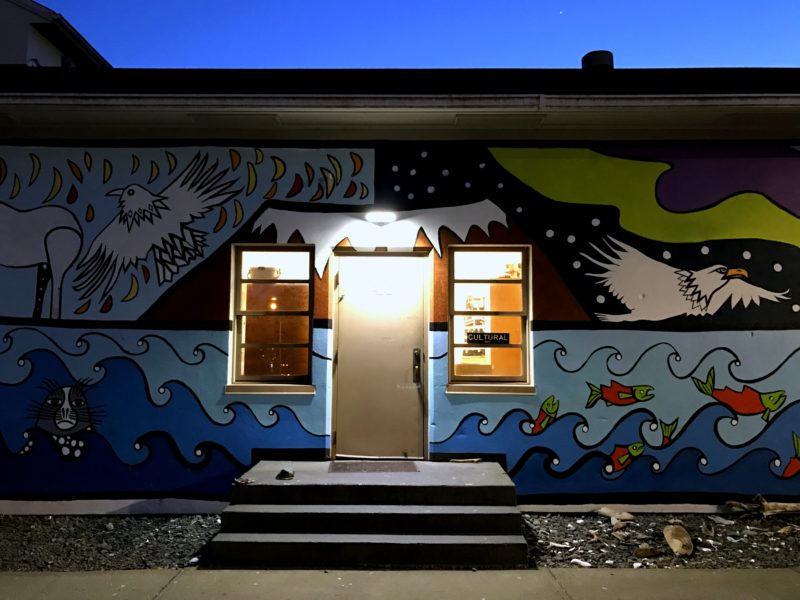
The Culture Room hosts akutaq Sunday, fry bread Friday, and is a space for students to make Native crafts. (Emily Russell/KCAW)
They still teach reading, writing, and math at Mt. Edgecumbe, but there are cultural extracurriculars, too.
“I yuraq sometimes, which is Eskimo dancing, or Yup’ik dancing.” explained Jerilyn Alexie.
Alexie is a senior from Pitkas Point, a place so small she usually tells people she’s from St. Mary’s, the village of 600 people just up the river.
When she’s not studying or at dance practice, Alexie comes to the Culture Room.
“I make kuspuks or earrings. I tried to make moccasins, but I didn’t have the patience to do that,” Alexie said.
Sophomore Shelby Samuel’s hometown is even smaller- Platinum, a village of just 55 people north of Bristol Bay.

Shelby Samuel is a sophomore at Mt. Edgecumbe from Platinum, a village of 55 people north of Bristol bay. (Emily Russell/KCAW)
“I get home sick once in a while. Sometimes I’ll wake up really homesick,” Samuel admitted.
Samuel said hunting is what he misses most.
“But then I’ll do something, like come here to the Culture Room, and yuraq,” Samuel explain. “I always wanted to learn how to yuraq– Yup’ik dance– and I’m finally learning how.”
Platinum, Samuel said, it’s too small to have Yup’ik dancing. But he’s able to learn about that and other parts of his culture here at Mt. Edgecumbe, more than 1,000 miles from home.






























